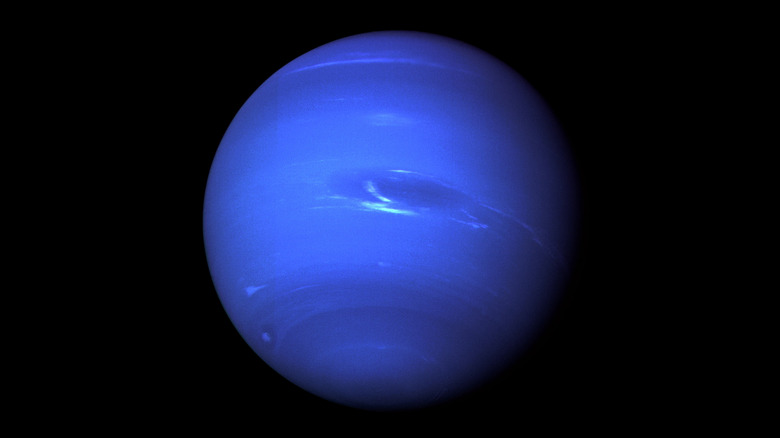It Would Take A Staggering Amount Of Time To Travel To The Farthest Planet From Earth In Our Solar System
Space is a pretty big place. Most people are aware of the incomprehensible size of the universe, but they probably forget just how vast our own solar system is. The fastest a normal person will ever travel is around 500 miles per hour on a passenger jet. At that speed, it takes over five hours to fly from Los Angeles to New York City. If you wanted to fly around the world at that speed, it would take you about 50 hours.
Traveling in space is an entirely different story. If you wanted to fly to the moon at 500 mph, it would take nearly 500 hours. Venus? Nearly 50,000 hours. Of course, if you were to fly somewhere in outer space, you would have to travel much faster than a passenger jet. If you know anything about Apollo 11 or watched the moon landing in 1969 (the furthest extent of human exploration of space), then you might have heard that the trip took around three days.
If you want to go beyond the moon to another planet, the time in transit jumps from days to months — or even years. Estimates for the transit time to Mars are somewhere around nine months. If you want to use the fastest manned rocket to get to Jupiter, expect the one-way trip to take over three years. But what about the planet furthest from the sun? How long would it take to get to Neptune?
How long does it take to get to Neptune?
If you want to get to Neptune, settle in for a long ride because it's really far away. The distance between Neptune and the sun is about 2.8 billion miles. Earth is a measly 93 million miles from the sun, so on the Earth's closest approach to Neptune, it's about 2.7 billion miles away. Traveling to Neptune in your average passenger jet would take you around 600 years. That's a long time.
Fortunately, there are faster ways to get to Neptune. So far, only one human probe has visited the Neptunian system, and that was Voyager 2, which was launched in 1977 and arrived in 1989. Over the 12 years it took to get to Neptune, Voyager 2's speed averaged around 42,000 mph. The Parker Solar Probe, which is currently orbiting the Sun, holds the record for fastest man-made object. In its orbit, it has reached speeds of nearly 395,000 mph. If a probe could be sent to Neptune at that speed, it would get there in about 10 months.
Most research today focuses on a travel time of around 15 years as a compromise between fuel costs and travel time. Any faster, and you have to sacrifice scientific equipment for fuel. Any longer, and the cost of maintaining the mission becomes too great.
When are we going to Neptune?
Sadly, no space agency has finalized any plans to return to Neptune, so if you're basing estimates on current proposals, it will be at least 10 years before another probe is sent its way, and around 15 more before it arrives. The earliest proposed mission comes from NASA and is called Neptune Odyssey. If NASA approves the mission, it would launch in 2033 and arrive at Neptune in the late 2040s. The China National Space Administration is toying with the idea of a similar mission called Tianwen-5 that would launch in 2040 and arrive in 2058.
Aside from these missions being mulled over by government agencies, there are at least two other highly developed mission proposals that have been put forth. One proposed mission, Nautilus, would launch in 2042 and arrive in the Neptunian system in 2057. Finally, there's the Arcanum mission (which includes a lander for the moon Triton!) which would launch in 2030 and arrive in 2045.
If any of these missions do happen, don't expect them to go in the air overnight. Based on NASA estimates, it takes around six years to move from getting a mission approved to having everything built and ready to launch.
Why should we go to Neptune?
If at this point you're asking yourself "why Neptune?" then don't fear; there are a few good reasons to be interested in the planet. First up are the characteristics of Neptune itself. Neptune is classified as an ice giant, which means it is largely composed of water, ammonia, and methane in contrast to the hydrogen and helium dominated sompositions of Jupiter and Saturn. Scientists are eager to know how these planets evolve, as it would further their understanding of solar system formation in general.
The other big draw of the Neptunian system is its largest moon, Triton, which is interesting for two big reasons. The first is that it may have water. When Voyager 2 flew past in 1989, it saw cracks in the surface of the moon, leading to theories that they were caused by the expansion of water as it freezes. Triton also orbits Neptune opposite to Neptune's rotation (retrograde) and with an extreme orbital inclination of 157 degrees. Because of this, scientists believe that Triton is a captured Kuiper Belt object, similar to Pluto (a theory which wouldn't have been possible without David Jewitt and Jane Luu's exploration of the Kuiper Belt back in the 1980s).
It's this potent combination of research targets that piques the curiosity of space researchers. Nowhere else in the solar system can you find an ice giant, a water moon, and a trans-Neptunian object larger than Pluto all within close proximity to each other.



